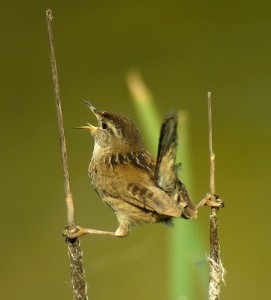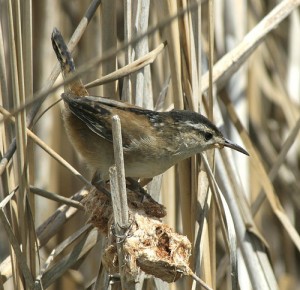Eastern & Western Marsh Wrens
Eastern & Western Marsh Wrens sing slightly different songs, and may well be two different cryptic species. Many birders are aware of this in the vague sense, but haven’t taken the time to figure out how to tell the two forms apart.
 |  |
| Western Marsh Wren, Marin County, CA, 4/18/2009. Photo by Len Blumin (Creative Commons 2.0). | Eastern Marsh Wren, Rockingham County, NH, 5/2/2007. Photo by Scott A. Young (Creative Commons 2.0). |
As the above photos show, identification by ear is going to be much easier than identification by eye — although these photos do nicely illustrate the slight average differences in crown color (browner in the west, blacker in the east).
So far, no one has reported any differences in the calls that the two Marsh Wrens make outside the breeding season, so this post will focus on songs. At first listen, the two forms can sound extremely similar. They both sing with the same pattern (that is, a couple of introductory notes followed by an unmusical trill):
Western Marsh Wren
Eastern Marsh Wren
Introductory notes
The easiest and most reliable way to separate the two forms is to listen to the introductory notes. The introductory notes of Western Marsh Wrens almost always consist of two quick, low, noisy “tuk” sounds. The second “tuk” usually runs right up against the start of the trill: “tuk tukRRRRRRRRRR.” Eastern Marsh Wrens, by contrast, very often start with a single nasal and/or buzzy note, which might be transliterated as “beer” or “bzt.” Listen for the difference in the songs above.
Some Eastern birds sing more complex introductions, giving 2-4 different kinds of introductory notes before the trill. Some of them — particularly in the far eastern part of their range, and especially coastal birds — can include so many different kinds of introductory notes that the overall impression is of a half-second warble preceding the final trill. They also frequently include some of these notes after the trill. Here’s a great example from upstate New York.
In another example from Florida, the bird goes crazy with high-pitched frantic warbles both before and after the trill; they may sound like distant fighting Killdeers, but they’re all Marsh Wren notes.
Tone quality
The tone quality of trills provides another important distinction. Western birds sing mostly noisy, unmusical notes, almost all of which sound like they could have been made by a typewriter or a stock ticker. The trills of an Eastern bird, meanwhile, tend to be more musical, although it’s a stretch to apply the word “musical” even to an Eastern Marsh Wren, since, at their loveliest, their trills tend to sound like someone rapidly shaking a fistful of coins. Nevertheless, listen closely to an Eastern trill for semi-musical “clinking” sounds or “piping” notes mixed in with other kinds of sounds.
Repertoire size
Both Eastern and Western Marsh Wrens sing with a repertoire of multiple song types, and they almost never sing the same song type twice in a row, preferring instead to cycle through almost their entire repertoire before repeating. According to Kroodsma & Verner (1997), Western males sing far more song types (100-200) than do Eastern males (40-60), but don’t bother trying to count them; instead, listen to the quality and complexity of the introductory notes and the trill.
Those familiar with Sedge Wrens may notice that Western Marsh Wren songs can be quite similar to songs of Sedge Wren, while Eastern Marsh Wren songs are less similar. However, Sedge Wrens can often be distinguished by their tendency to repeat one song type over and over again before switching to another. Unlike Marsh Wrens, they only cycle through their repertoires when excited, “during the dawn hour or during intense countersinging” (BNA). Here’s a Sedge Wren for comparison:
3 thoughts on “Eastern & Western Marsh Wrens”
Another informative and timely post. I’ve been photographing the marsh wrens out in BC this week (Iona Island, near Vancouver Airport), and some of them are almost rufous especially on the tail feathers. Their calls are very similar to the one you have linked including the double tut intro notes. When I head back east I’ll photograph and record those marsh wrens for comparison.
Incidentally, to my ear the Sedge Wren sounds more ‘musical’ than the Marsh Wren. I hear that bell-like quality that you can hear in many Dark-eyed Juncos.
btw, the links to the New York and Florida examples are broken (page not found).
That’s odd about the links — they’re working for me. If anybody else has trouble with them, please drop me a line.
Hm…they work for me now. Their site probably was down for a short time.
Comments are closed.